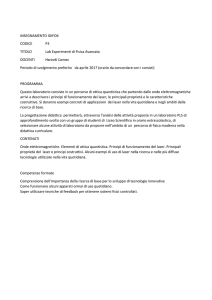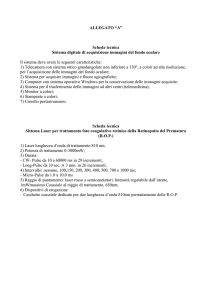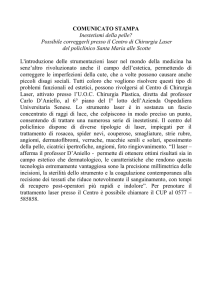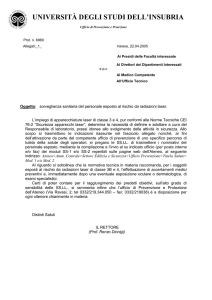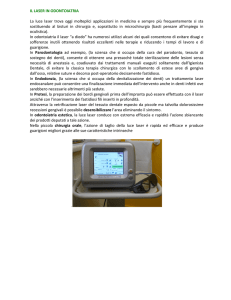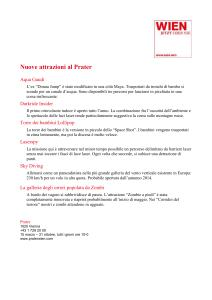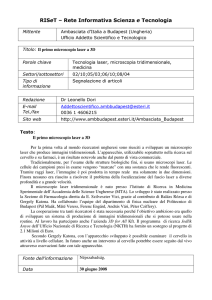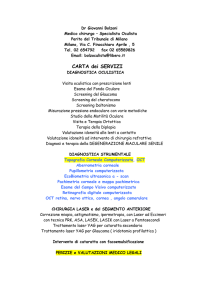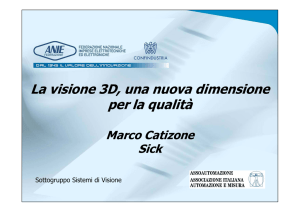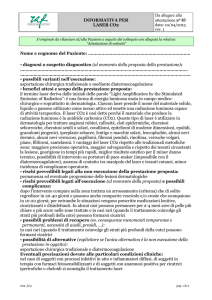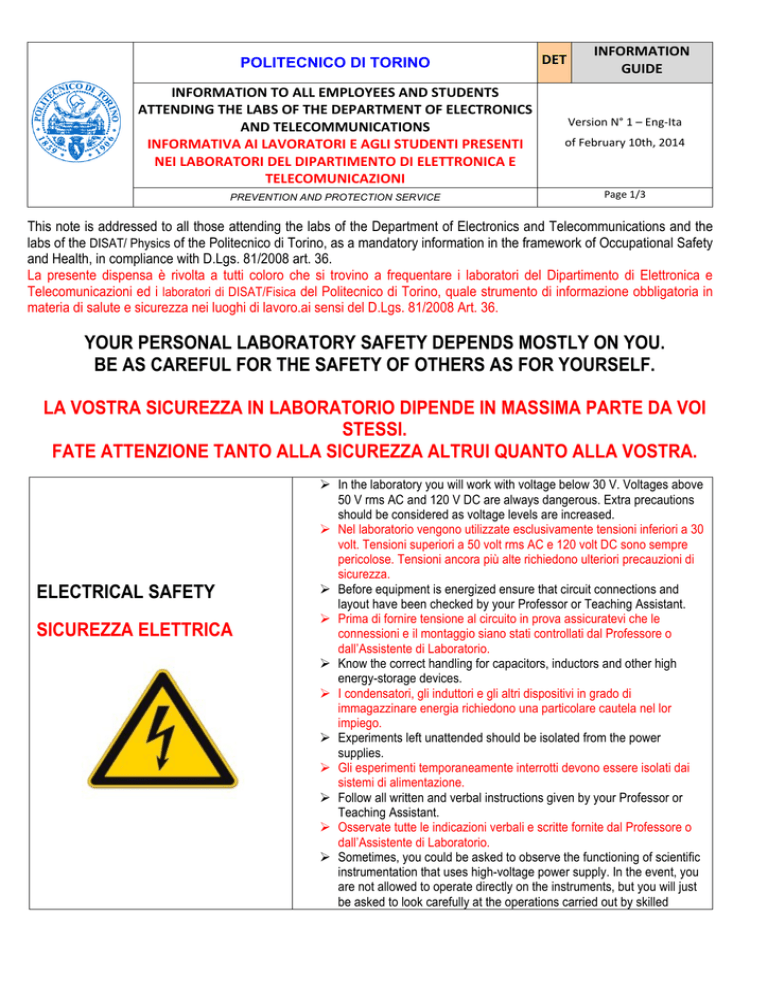
POLITECNICO DI TORINO
INFORMATION TO ALL EMPLOYEES AND STUDENTS ATTENDING THE LABS OF THE DEPARTMENT OF ELECTRONICS AND TELECOMMUNICATIONS
INFORMATIVA AI LAVORATORI E AGLI STUDENTI PRESENTI NEI LABORATORI DEL DIPARTIMENTO DI ELETTRONICA E TELECOMUNICAZIONI PREVENTION AND PROTECTION SERVICE
DET INFORMATION GUIDE Version N° 1 – Eng‐Ita of February 10th, 2014 Page 1/3 This note is addressed to all those attending the labs of the Department of Electronics and Telecommunications and the
labs of the DISAT/ Physics of the Politecnico di Torino, as a mandatory information in the framework of Occupational Safety
and Health, in compliance with D.Lgs. 81/2008 art. 36.
La presente dispensa è rivolta a tutti coloro che si trovino a frequentare i laboratori del Dipartimento di Elettronica e
Telecomunicazioni ed i laboratori di DISAT/Fisica del Politecnico di Torino, quale strumento di informazione obbligatoria in
materia di salute e sicurezza nei luoghi di lavoro.ai sensi del D.Lgs. 81/2008 Art. 36.
YOUR PERSONAL LABORATORY SAFETY DEPENDS MOSTLY ON YOU.
BE AS CAREFUL FOR THE SAFETY OF OTHERS AS FOR YOURSELF.
LA VOSTRA SICUREZZA IN LABORATORIO DIPENDE IN MASSIMA PARTE DA VOI
STESSI.
FATE ATTENZIONE TANTO ALLA SICUREZZA ALTRUI QUANTO ALLA VOSTRA.
ELECTRICAL SAFETY
SICUREZZA ELETTRICA
¾ In the laboratory you will work with voltage below 30 V. Voltages above
50 V rms AC and 120 V DC are always dangerous. Extra precautions
should be considered as voltage levels are increased.
¾ Nel laboratorio vengono utilizzate esclusivamente tensioni inferiori a 30
volt. Tensioni superiori a 50 volt rms AC e 120 volt DC sono sempre
pericolose. Tensioni ancora più alte richiedono ulteriori precauzioni di
sicurezza.
¾ Before equipment is energized ensure that circuit connections and
layout have been checked by your Professor or Teaching Assistant.
¾ Prima di fornire tensione al circuito in prova assicuratevi che le
connessioni e il montaggio siano stati controllati dal Professore o
dall’Assistente di Laboratorio.
¾ Know the correct handling for capacitors, inductors and other high
energy-storage devices.
¾ I condensatori, gli induttori e gli altri dispositivi in grado di
immagazzinare energia richiedono una particolare cautela nel lor
impiego.
¾ Experiments left unattended should be isolated from the power
supplies.
¾ Gli esperimenti temporaneamente interrotti devono essere isolati dai
sistemi di alimentazione.
¾ Follow all written and verbal instructions given by your Professor or
Teaching Assistant.
¾ Osservate tutte le indicazioni verbali e scritte fornite dal Professore o
dall’Assistente di Laboratorio.
¾ Sometimes, you could be asked to observe the functioning of scientific
instrumentation that uses high-voltage power supply. In the event, you
are not allowed to operate directly on the instruments, but you will just
be asked to look carefully at the operations carried out by skilled
POLITECNICO DI TORINO
INFORMATION TO ALL EMPLOYEES AND STUDENTS ATTENDING THE LABS OF THE DEPARTMENT OF ELECTRONICS AND TELECOMMUNICATIONS
INFORMATIVA AI LAVORATORI E AGLI STUDENTI PRESENTI NEI LABORATORI DEL DIPARTIMENTO DI ELETTRONICA E TELECOMUNICAZIONI PREVENTION AND PROTECTION SERVICE DET INFORMATION GUIDE Version N° 1 – Eng‐Ita of February 10th, 2014 Page 2/3 technicians. Please remind to always comply with the security
instructions which are indicated by appropriate safety signs.
¾ In taluni casi, poterete essere chiamati ad osservare il funzionamento
di strumenti che possono far uso di tensioni elettriche elevate. In tali
casi, non Vi sarà chiesto di azionare direttamente lo strumento ma di
osservarne attentamente il funzionamento ad opera di un addetto
specializzato. Seguite sempre le istruzioni di sicurezza segnalate dagli
appositi cartelli.
LASERS SAFETY
SICUREZZA DEI LASER
¾ Never, ever look into any laser beam, no matter how low power or "eye
safe" you may think it is.
¾ Non guardate mai e poi mai un fascio laser, anche se ritenete essere di
bassa potenza.
¾ Always wear safety goggles if instructed by your Professor or Teaching
Assistant.
¾ Indossate sempre gli occhiali di sicurezza come da indicazioni del
Professore o dell’Assistente di Laboratorio.
¾ The most common injury using lasers is an eye injury resulting from
scattered laser light reflected off of mountings, sides of mirrors or from
the "shiny" surface of an optical table. The best way to avoid these
injuries is to always wear your goggles and never lower your head to
the level of the laser beam. The laser beam should always be at or
below chest level.
¾ La luce laser riflessa dai supporti, dagli specchi o dalle superfici
“lucide” di un tavolo ottico può creare lesioni oculari. Il modo migliore
per evitare danni oculari è di indossare sempre occhiali protettivi e mai
abbassare la testa fino al livello del fascio laser. Il fascio laser deve
sempre essere più in basso del torace.
¾ Always use "beam stops" to intercept laser beams. Never allow them to
propagate into the laboratory. Never walk through a laser beam.
¾ Usate gli appositi dispositivi per intercettare un fascio laser. Non
lasciate propagare il fascio laser nel laboratorio. Non attraversate mai
un fascio laser.
¾ If you suspect that you have suffered an eye injury, notify your
Professor or Teaching Assistant immediately. Your ability to recover
from an eye injury decreases the longer you wait for treatment.
¾ Se sospettate di esservi procurati una lesione oculare, avvertite
immediatamente il Professore o l’Assistente di Laboratorio. La
possibilità di guarire una lesione oculare diminuisce quanto più tempo
fate passare prima di un intervento medico.
¾ Follow all written and verbal instructions given by your Professor or
Teaching Assistant.
¾ Osservate tutte le indicazioni verbali e scritte fornite dal Professore o
dall’Assistente di Laboratorio.
POLITECNICO DI TORINO
INFORMATION TO ALL EMPLOYEES AND STUDENTS ATTENDING THE LABS OF THE DEPARTMENT OF ELECTRONICS AND TELECOMMUNICATIONS
INFORMATIVA AI LAVORATORI E AGLI STUDENTI PRESENTI NEI LABORATORI DEL DIPARTIMENTO DI ELETTRONICA E TELECOMUNICAZIONI PREVENTION AND PROTECTION SERVICE DET INFORMATION GUIDE Version N° 1 – Eng‐Ita of February 10th, 2014 Page 3/3 THE FOLLOWING INSTRUCTIONS PROVIDE GUIDELINES FOR HANDLING TWO
TYPES OF ELECTRICAL EMERGENCIES.
LE ISTRUZIONI SEGUENTI FORNISCONO ALCUNE LINEE GUIDA PER
AFFRONTARE LE PIÙ COMUNI EMERGENZE DI TIPO ELETTRICO.
ELECTRIC SHOCK
SCOSSA ELETTRICA
ELECTRICAL FIRE
INCENDIO ELETTRICO
¾ When someone suffers serious electrical shock, he or she may be
knocked unconscious. If the victim is still in contact with the electrical
current, immediately turn off the electrical power source.
¾ La vittima di una scossa elettrica potrebbe avere perso conoscenza.
Se la vittima è ancora in contatto con la corrente elettrica, staccate
immediatamente la sorgente di alimentazione.
¾ Do not touch a victim that is still in contact with a live power source;
you could be electrocuted.
¾ Non toccate la vittima se è ancora in contatto con la sorgente di
alimentazione; potreste rimanere folgorati.
¾ Call the Reception desk immediately (011-0907777).
¾ Avvertite immediatamente la portineria (011-0907777).
¾ It is your responsibility to read safety and fire alarm posters and follow
the instructions during an emergency.
¾ È vostra cura leggere tutti gli avvisi di sicurezza appesi nel laboratorio
e seguire le istruzioni relative in caso di emergenza.
¾ Know the building evacuation procedures.
¾ Dovete essere a conoscenza delle procedure di evacuazione.
¾ If an electrical fire occurs, try to disconnect the electrical power source,
if possible.
¾ Se si verifica un incendio di origine elettrica tentate, se possibile, di
scollegare la sorgente di alimentazione.
¾ Never use water to extinguish an electrical fire.
¾ Non usare mai acqua per spegnere un incendio di origine elettrica.
¾ Call the Reception desk immediately (011-0907777).
¾ Avvertite immediatamente la portineria (011-0907777).
¾ It is your responsibility to read safety and fire alarm posters and follow
the instructions during an emergency.
¾ È vostra cura leggere tutti gli avvisi di sicurezza appesi nel laboratorio
e seguire le istruzioni relative in caso di emergenza.
¾ Know the building evacuation procedures.
¾ Dovete essere a conoscenza delle procedure di evacuazione.

